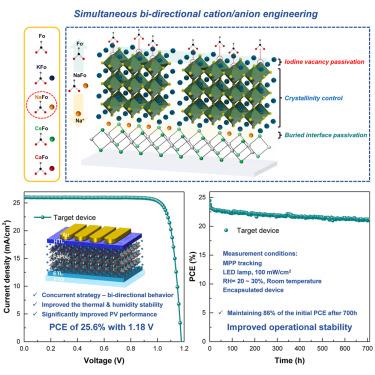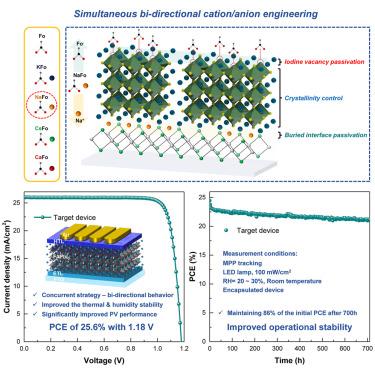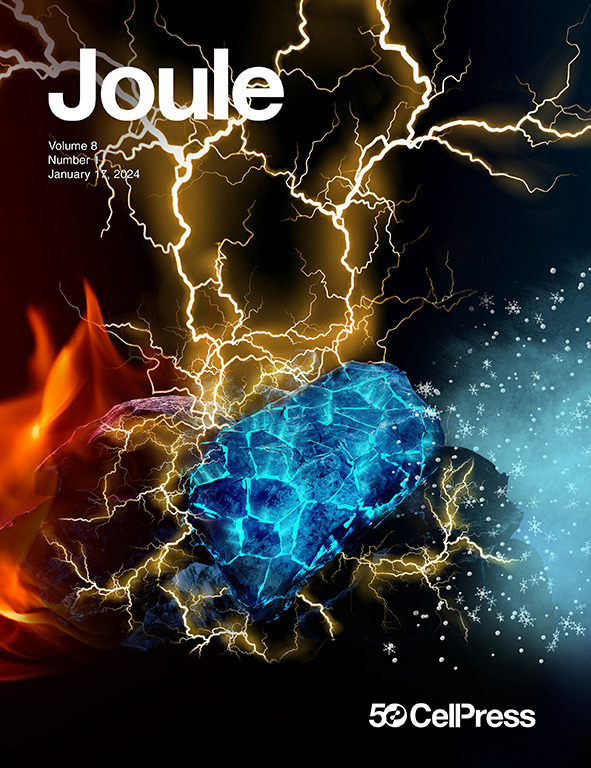Designed bi-directional cation/anion interfacial distribution of perovskite solar cells
IF 38.6
1区 材料科学
Q1 CHEMISTRY, PHYSICAL
引用次数: 0
Abstract
Pseudo-halide anion formate (HCOO−) in halide perovskite has been widely employed to improve film quality without altering the band gap. However, there is a lack of understanding regarding the effect on perovskite films depending on the chemical bonding state of formate. Herein, we demonstrated the distinguishable crystallization behavior of FAPbI3 film by comparing the formate salts with different bonding states. Furthermore, we found that distinct passivation mechanisms depended on the cations of formate salts, which resulted in the differences in device performance. Notably, sodium-based formate exhibited simultaneous bi-directional behavior of cation and anion, distinguishing it from other formate salts. Consequently, the device exhibited an enhanced power conversion efficiency (PCE) of 25.6% with a significantly high open-circuit voltage (Voc) of 1.18 V. This work provides insights into the effect on the chemical bonding state of formate, as well as different passivation mechanisms depending on the cations of formate salts.


设计双向阳离子/阴离子界面分布的过氧化物太阳能电池
为了在不改变带隙的情况下提高薄膜质量,人们广泛采用了卤化物包晶石中的伪卤化物阴离子甲酸盐(HCOO-)。然而,人们对甲酸盐的化学键状态对包晶石薄膜的影响还缺乏了解。在此,我们通过比较不同键合状态的甲酸盐,证明了 FAPbI3 薄膜的不同结晶行为。此外,我们还发现不同的钝化机制取决于甲酸盐的阳离子,这导致了器件性能的差异。值得注意的是,钠基甲酸盐同时表现出阳离子和阴离子的双向行为,使其有别于其他甲酸盐。因此,该器件的功率转换效率 (PCE) 提高了 25.6%,开路电压 (Voc) 明显提高到 1.18 V。这项研究深入探讨了甲酸盐化学键状态的影响,以及甲酸盐阳离子不同所导致的不同钝化机制。
本文章由计算机程序翻译,如有差异,请以英文原文为准。
求助全文
约1分钟内获得全文
求助全文
来源期刊

Joule
Energy-General Energy
CiteScore
53.10
自引率
2.00%
发文量
198
期刊介绍:
Joule is a sister journal to Cell that focuses on research, analysis, and ideas related to sustainable energy. It aims to address the global challenge of the need for more sustainable energy solutions. Joule is a forward-looking journal that bridges disciplines and scales of energy research. It connects researchers and analysts working on scientific, technical, economic, policy, and social challenges related to sustainable energy. The journal covers a wide range of energy research, from fundamental laboratory studies on energy conversion and storage to global-level analysis. Joule aims to highlight and amplify the implications, challenges, and opportunities of novel energy research for different groups in the field.
 求助内容:
求助内容: 应助结果提醒方式:
应助结果提醒方式:


